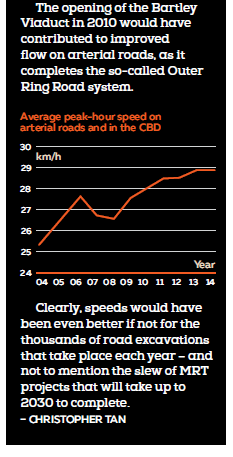Why having more cars does not always mean having more congestion.


Why having more cars does not always mean having more congestion.

THE Government has been reining in Singapore’s car population growth with renewed fervour in recent years. From 3 percent per year, the allowable growth rate has been cut repeatedly, and is now at a dismal 0.25 percent. If that was not enough, the Senior Minister of State for Transport, Josephine Teo, told Parliament in March that the rate is likely to go down to zero in the future – reversing Transport Minister Lui Tuck Yew’s previous position. No doubt the usual reasons would spring forth if one were to ask “Why?”. Singapore is a small city state; 12 percent of land is already taken up by roads versus 14.5 percent occupied by housing.
More than four in 10 households already own a car. And once people own a car, they will drive it indiscriminately, causing congestion and pollution… and so on, and so forth. Well, after analysing various sets of statistics compiled by the Land Transport Authority, it appears that some assumptions may have to be revised. Firstly, motorists are driving less. In fact, the average annual mileage clocked by a passenger car has been on a continuous decline since 2006. Last year, the average was 17,500km – nearly 20 percent lower than the 21,075km clocked eight years ago.

Higher fuel prices and steeper electronic road pricing (ERP) charges may have been the main reasons for this. From a low of about $1.50 a litre in 2002, pump pric es climbed to $2.20 last year, before being pulled down by falling oil pric es (and then raised by a petrol duty hike). ERP rates have also crept up over the same period, with peak prices doubling from $3 to $6. Along with soaring parking rates in the city centre, these factors may have nudged some drivers to take public transport on weekdays, either fully or partially.
And because heartland shopping malls and cinemas have sprouted in the last decade or so, city-bound traffic may also have dropped. Saturday ERP may have been another deterrent for some shoppers who might otherwise have gone to Orchard Road or Marina Bay. Why bother driving to downtown shops when neighbourhood malls are nearly just as comprehensive? Although a more thorough investigation is necessary to pin down the exact reasons for the drop in annual mileage, the fact is that said mileage has fallen – noticeably.


But does lower mileage translate to better traffic? In this case, it does. According to another set of stats (see box story on the right), our roads are generally more free-flowing than they have ever been in the past decade. What the improved speeds tell us is this: Despite the car population having grown by some 50 percent in the last decade to about 620,000, we have not come to a gridlock. Neither has the island turned into a giant carpark. In fact, people have tempered their use of the car, resulting in what would have been unthinkable in any other city: an improvement in traffic conditions on the back of a huge growth in vehicle population.
From the evidence, Singapore can possibly accommodate more cars. It can do so by applying more usage-demand measures (which the nextgeneration ERP is suitably capable of doing), and it can do so by accelerating the decentralisation programme. And of course it can do so b y having better road designs and fewer roadworks. There is really no need for the Singapore Government to take a sledgehammer approach to car population control. No need to stifle the natural aspirations of a hardworking and increasingly affluent population in such an absolute and draconian way. No need for tired rhetoric on why we cannot have more cars (but can have a lot more people). In short, there is absolutely no need for a zero-growth policy.























